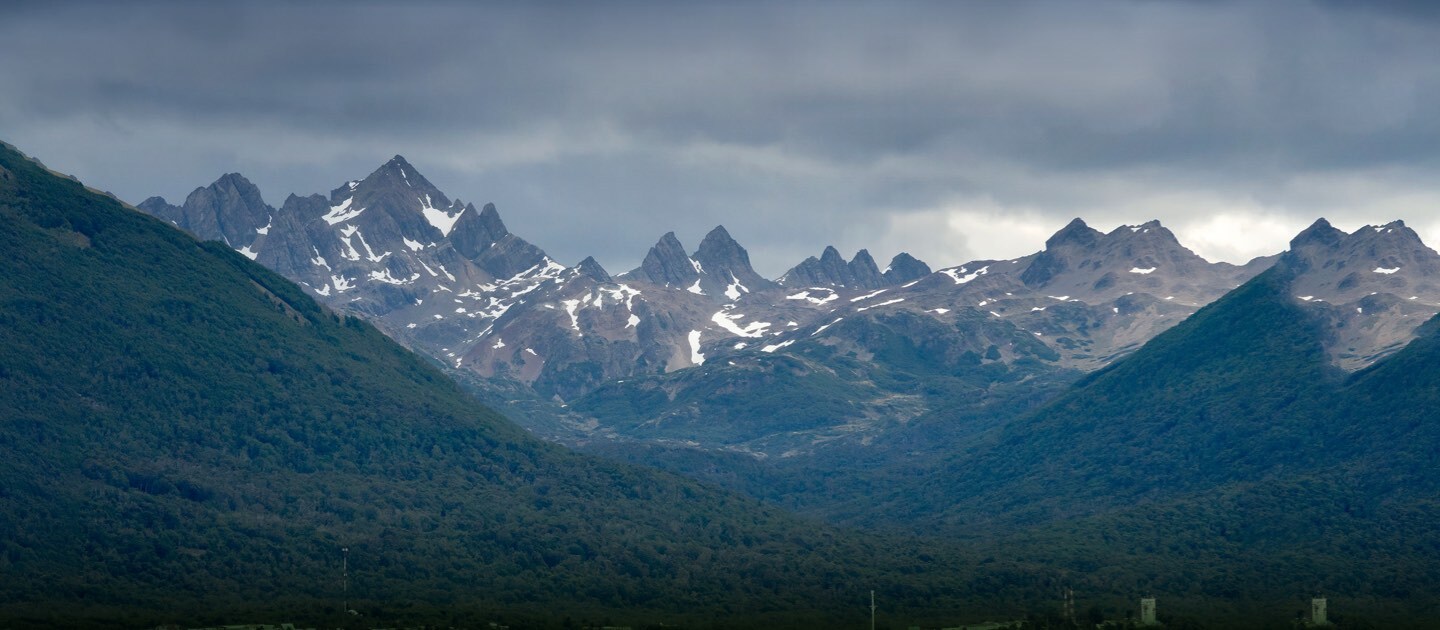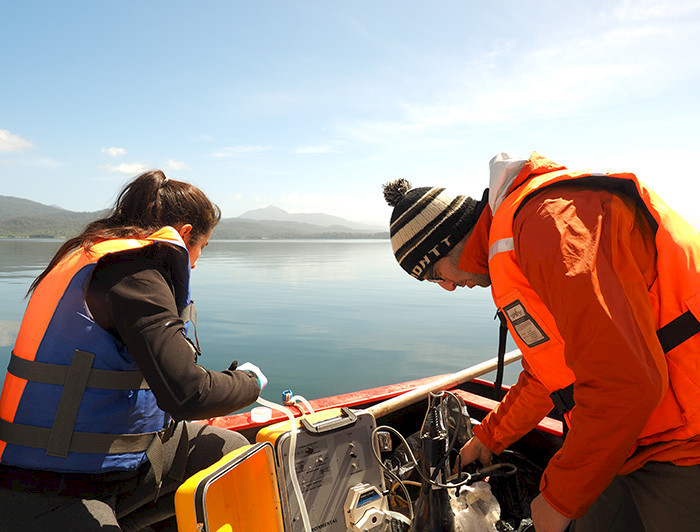
Find Out What UC Chile Has Been Researching in Patagonia
The impact of climate change on glaciers and the effects of human activities on the Patagonian ecosystem are just some of the topics studied at the UC Chile Patagonia Station. Here are the results of the last four years of work in one of the last virgin corners of our country.

photo_camera The objective of this meeting was to disseminate the knowledge that has been generated about the Aysén Region, particularly the Valle Exploradores area, during the last few years at the UC Chile Patagonia Station, with support from France (CNRS). (Photo credit: Cupquelan Fjord/Nicole Saffie)
Over the past four years, researchers at the Patagonia Station for Interdisciplinary Research (EPII UC Chile) have been working tirelessly, without letting the pandemic get in the way of making progress on important issues.
The results of their research have been made possible by several factors:
- The university's interest in studying the area.
- The concession—renewed by the Ministry of National Assets—that allows researchers in the area.
- The support of the French National Centre for Scientific Research through the Institut Ecologie et Environnement and its network of Human-Environment observatories.
Their progress has been compiled into a series of presentations which are explained and shared below.
Glaciers Under Threat
The station is located in Valle Exploradores, one of the most beautiful and least known places in the Aysén region, some 300 km south of Coyhaique.
The area is known for its many glaciers, which are what caught the attention of Esteban Sagredo, researcher and professor of the Institute of Geography.
He has focused on understanding how these huge masses of frozen water are responding to periods of extreme heat (click here to watch the Spanish presentation “Glacier in Crisis: How Responsive are Patagonian Glaciers to Extreme Warm Periods?”)
Because of global warming, glaciers around the world are melting at rates that exceed the most dire predictions.
Changes in mountain glaciers are causing dramatic impacts both physically (landslides and floods) and ecologically (altering ecosystems).

As Professor Sagredo has explained:
“We are presenting a new approach to identify the response of Patagonian glaciers to extreme warm conditions in the past, based on the state-of-the-art ‘cosmogenic nuclide’ technique.
This method can measure surface exposure ages, erosion rates of rocks, as well as the ages of soil and sediment deposits.
This will be essential to determine whether the magnitude of the current deglaciation is unique and unprecedented in recent geological history and allow us to put the response of glaciers to current climate change into context.
Human Impact on Ecosystems
Another investigation being carried out at the UC Chile Patagonia Station studies how industrial activity affects Patagonian ecosystems. (Click here to watch the Spanish presentation “Interactions Between Physico-chemical Parameters and Microbial Community Structure in Exploradores River Basin Within Patagonian Fjord System”)
This research is being conducted by Rodrigo de la Iglesia, professor of the Faculty of Biological Sciences.
As he has explained, Patagonian fjord ecosystems are vulnerable to increasing industrialized activities in the region, but the impact of these activities on river or marine systems is still unclear, something his research seeks to understand.
“We are developing the baseline characterization of the Exploradores river basin and its discharge into the Cupquelán fjord, in terms of water quality and trace element content. We are also working to describe the main planktonic organisms and the molecular composition of the microbial communities in the area using samples that were collected between 2015 and 2017.”
Meanwhile, Paul Amouroux, a researcher in the Faculty of Agriculture and Forestry Engineering, is investigating the insects found in Bahía de Exploradores. (Click here to watch the Spanish presentation “Artrópodos de Bahía Exploradores como bioindicadores de las actividades humanas: Identificación de su diversidad y abundancia [Arthropods of Bahía Exploradores as Bioindicators of Human Activities: Identification of Their Diversity and Abundance].”
Terrestrial arthropods, and insects in particular, account for about 60% of all species living on Earth, but only 20% have been recorded.
Although they play an important role in ecosystems—pest control, pollination, recycling of organic matter, among others—, they are threatened by human activities, land use change, and climate change.
Amouroux explained that although "arthropods are widely used as bioindicators to describe and monitor the impact of these factors, the entomofauna [insect life] of the Aysén region and Bahía Exploradores is still unknown.”
His research has consisted of comparing the arthropod communities of the UC Chile Patagonia Station, where there has been no human presence for the last 50 years, and the Teresa area, which has a contemporary human settlement.
During 2019, 2020, and 2021, he collected samples and worked on the taxonomic identification as well as updating the distribution, ecological, and biological data.

Other research being carried out includes:
- “Espacialización de plantas exóticas invasoras a través de imágenes de drones en la Patagonia chilena” [Spatialization of Invasive Alien Plants Through Drone Imagery in Chilean Patagonia], by Eric Maire, researcher at Laboratoire Image, Ville, Université de Strasbourg (watch the Spanish presentation);
- “The Ecology of Invasive Brown Trout in Bahía Exploradores, Chile,” by Julien Cucherousset, from the Laboratoire Évolution et Diversité Biologique, Université Paul Sabatier (watch the English presentation);
- “Transformaciones socioterritoriales en el Valle Exploradores: colonización ganadera y turística en perspectiva geohistórica” [Socio-territorial Transformations in Valle Exploradores: Livestock and Tourist Colonization from a Geo-historical Perspective], by Jorge Olea, from the Department of Environmental Sciences at Universidad Católica de Temuco (watch the Spanish presentation);
- “Patrones de actividad de carnívoros a lo largo de un gradiente de intervención en el bosque templado de Bahía Exploradores” [Patterns of Carnivore Activity Along a Gradient of Intervention in the Temperate Forest of Bahía Exploradores], by Paula Zucolillo, researcher at the Center for Applied Ecology and Sustainability (CAPES) UC Chile (watch the Spanish presentation);
- “ARGS: Ocurrencia de genes de resistencia antimicrobiana en los ríos del Valle Exploradores” [ARGS: Occurrence of Antimicrobial Resistance Genes in the Rivers of Valle Exploradores], by Fernando Alfaro, professor at the Genomics, Ecology, and Environment Centre (GEMA) of Universidad Mayor, and researcher at the Institute of Ecology and Biodiversity (watch the Spanish presentation).
Working Together with France
Since 2018, the Station has been part of a research "device" that includes a network of 13 Human-Environment Observatories (LabEx DRIIHM), of the National Institute of Ecology and Environment (INEE), an institution belonging to the French National Centre for Scientific Research (CNRS).
The results of this joint effort were presented in March 2022 at a conference at the San Joaquín Campus in Santiago.
The Station's director, and professor at the Institute of Geography, Alejandro Salazar, expressed the importance of disseminating the knowledge that has been generated about the area in recent years thanks to the support from France.
"It is important, and part of our work, that the results and advances that are made in these research projects can reach both the people who live in the territory and those who have a scientific interest in it, thus nurturing the research process itself and its contributions. That is why we wanted the results to be presented in a hybrid mode, so they could be accessed by people anywhere.” This way it could reach people in different parts of Chile.
UC Chile Research Director María Elena Boisier said:
“The cooperation with France is of great importance for our university. This is the only Human-Environment Observatory project in Chile. We hope that through these opportunities we can promote dialogue and academic reflection to achieve the exchange of knowledge, implement new forms of collaboration, and solve scientific problems of mutual interest.”
During the conference, the presentations mentioned above were given, common cross-cutting themes were discussed, and ideas were exchanged on the basis of interdisciplinary action in the Patagonian territory.
The presentations were recorded by the Laboratory of Excellence “Dispositif de Recherche Interdisciplinaire sur les Interactions Hommes-Milieux” (LabEx DRIIHM) of the CNRS, to which the OHM network belongs, and published as video capsules on its website.


